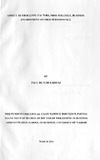| dc.contributor.author | Awino, Zachary Bolo | |
| dc.contributor.author | Kariuki, Paul Muturi | |
| dc.date.accessioned | 2013-02-13T14:50:30Z | |
| dc.date.available | 2013-02-13T14:50:30Z | |
| dc.date.issued | 2012 | |
| dc.identifier.citation | DBA Africa Management Review: 2012, Vol 2 No 1, 77-98 | en |
| dc.identifier.uri | http://erepository.uonbi.ac.ke:8080/xmlui/handle/123456789/9812 | |
| dc.description.abstract | Contingency theory contends that there is no universal or one best way to manage or
design an organization and its subsystems must 'fit' with the environment. Effective
organizations need not only have a proper 'fit' with the environment but also among its
subsystems. Organization operates in a turbulent environment and they depend on the
environment for resources input and produce goods or service for the consumption by the
environment. Strategy is the link to the environment and to achieve its objectives the
organization adopt strategies that align them with environment which is aimed at avoiding
any mismatch between the organization and the environment. Firm performance is
contingent to both firm and industry factors. There have been conflicting views on which
factors are more important in influencing strategy and performance. Resource based view
of strategy has dominated in theoretical and empirical literature and the variation in firm
level factors explains the difference in strategy chosen which influences the organization
performance. This paper reviews the influence of different contingent variables on firm
performance but emphasizes that there is need to study the joint effect of different firm
factors apart from the independent effect. | en |
| dc.language.iso | en | en |
| dc.subject | Firm level factors | en |
| dc.subject | Environment | en |
| dc.subject | Performance | en |
| dc.title | Firm Strategy, Business Environment and the Relationship Between Firm Level Factors and Performance | en |
| dc.type | Article | en |
| local.publisher | School of Business | en |

